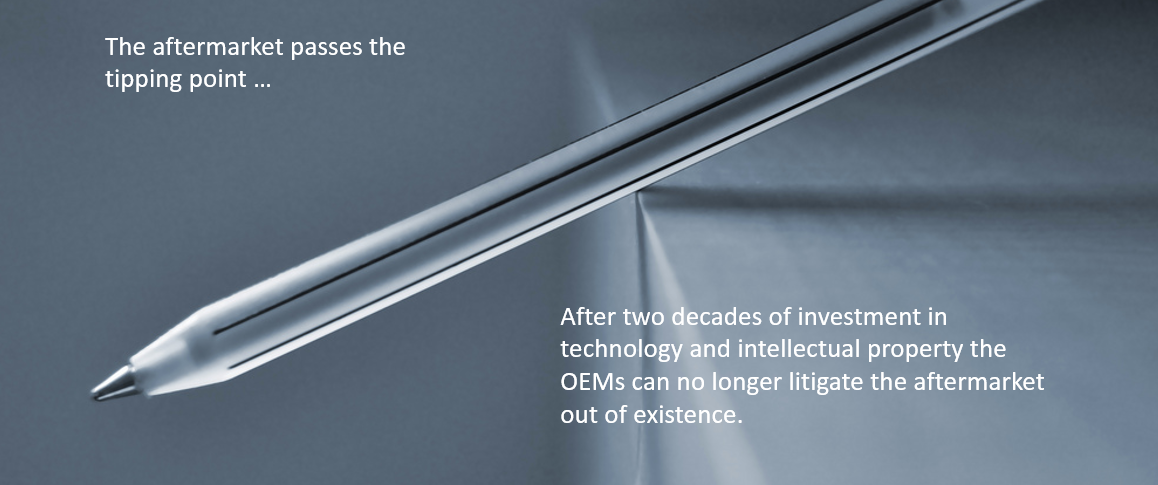 For veterans in the office supplies industry, patents and the potential for disputes have been a way of life for 25 years or more. I recall my first experiences in the early nineties and the steep learning curve that followed. Working for one of the more prominent aftermarket manufacturers, patents, and the potential for litigation became a daily concern. As 1995 rolled around, we faced concurrent litigation from three global OEMs. While never directly putting the company out of business, it became a significant distraction for management and contributed to an eventual Chapter 11 bankruptcy proceeding.
For veterans in the office supplies industry, patents and the potential for disputes have been a way of life for 25 years or more. I recall my first experiences in the early nineties and the steep learning curve that followed. Working for one of the more prominent aftermarket manufacturers, patents, and the potential for litigation became a daily concern. As 1995 rolled around, we faced concurrent litigation from three global OEMs. While never directly putting the company out of business, it became a significant distraction for management and contributed to an eventual Chapter 11 bankruptcy proceeding.
There have been many developments and changes over these 25 years.
The technologies required to make ink and toner cartridges have advanced exponentially.
Most small remanufacturers in the Western markets have become resellers after conceding the technology and quality race to the large manufacturers.
Chinese aftermarket manufacturers have become the global superpowers
There are three main points to consider;
Throughout this period and despite these changes, every aftermarket manufacturer and reseller has had to watch for the constant threat of patent disputes. The industry has evolved where only the most prominent manufacturers can afford the legal resources to locate, research, and understand all the relevant patents. They alone have the engineering resources to develop a design-around to bring high-quality, competitive products to market safely. As a result, resellers in the developed economies of Europe and North America have primarily relied on these more prominent players to stay in business.
Behind these manufacturers is a network of advanced technology companies supplying critical components and engineering resources that help the aftermarket overcome ongoing intellectual property challenges. Overall, the depth of technical resources supporting the aftermarket is remarkable.
More recently, there have been stunning advances in the capitalization of the top tier of Chinese manufacturers, with multiple public stock offerings taking place during 2015 and 2016. Who would have thought that Ninestar, barely fifteen years from founding, would have completed a multi-billion dollar offering for its Apex chip business?
With these developments and events, the manufacturing industry for aftermarket office supplies has passed a significant tipping point and can no longer be prosecuted out of existence. The combination of its intellectual property advances, technological know-how, and its raising of large amounts of capital now makes this all but impossible. In earlier years, such an "extinction" event remained a possibility and may even have been one of the OEM's motivations as a tactic to try and bleed the aftermarket to death.
The aftermarket has passed a major tipping point and can no longer be litigated out of existence.
However, although the aftermarket is here to stay, I'm not suggesting for a moment that the threat of patent litigation has diminished. If anything, it's probably increased, as will be explored later in this series of articles. Think about it this way, just like global giants such as Apple and Samsung litigate against each other, neither will put the other out of business. Some money may eventually change hands, and the lawyers charge enormous fees, but the company continues.
A similar scenario to the Apple Vs. Samsung example referenced here now exists between the OEMs and the remaining global aftermarket players in the imaging supplies business. Litigation around patent disputes will continue, but neither side will put the other out of business.
Reaching this tipping point is likely to have numerous ramifications for the OEM and aftermarket sectors, as will be examined in subsequent articles;
OEM consolidation – i.e., Lexmark, Samsung, Sharp, Xerox
New-Build compatible cartridges, sidelining of the "First-Sale" legal barrier and the historical market share constraints
The battleground for market share and the impact on Amazon, DepotMax & Staples
In this upcoming series of blogs, I will be examining the potential for the aftermarket to significantly increase its share of the overall market in the Western developed economies, particularly the United States and Canada.
